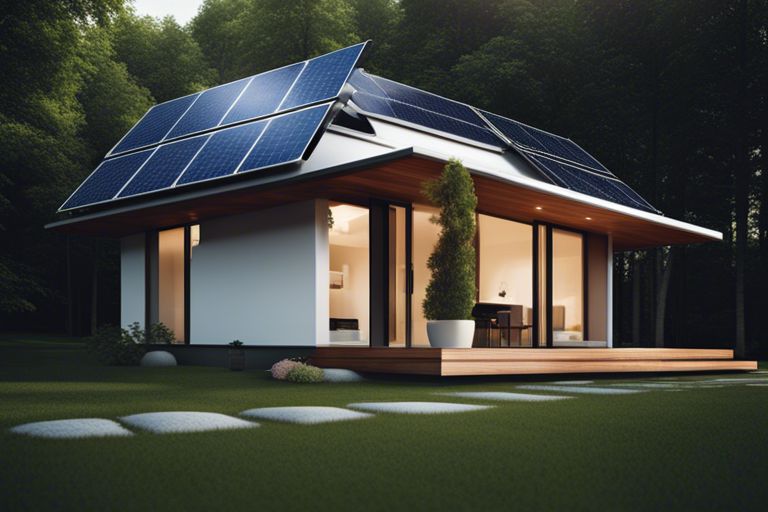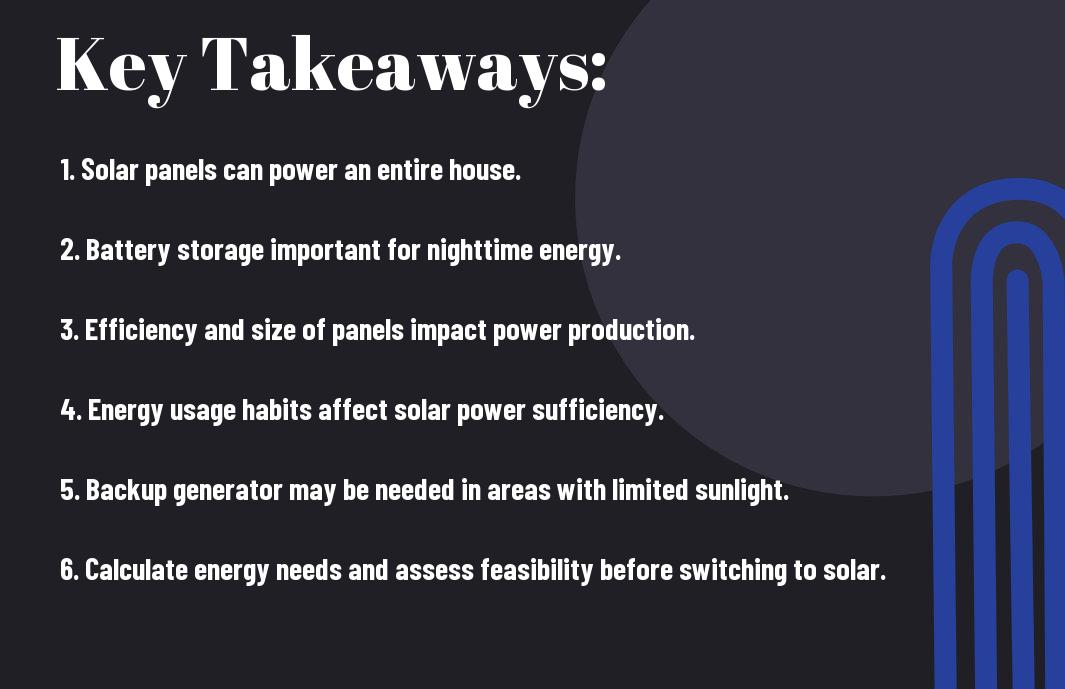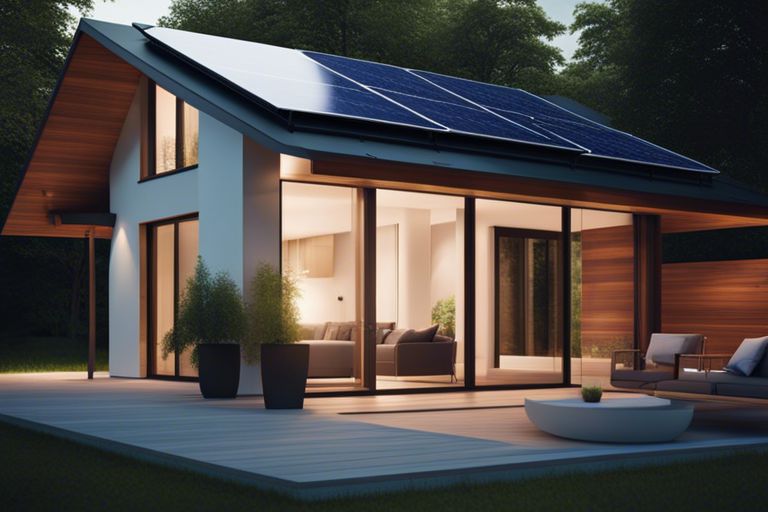It’s time to shed light on the question: Can a house run on solar power alone? Imagine the possibility of achieving energy independence and reducing your carbon footprint. In this informative blog post, we will research into the practicality, benefits, and challenges of transitioning to a solar-powered home. Get ready to uncover the fascinating world of solar energy and its potential to revolutionize the way you power your home.

Key Takeaways:
- Solar panels are not always sufficient: Relying solely on solar power may not always provide enough energy to fully power a house.
- Energy storage is crucial: Batteries are necessary to store excess energy produced by solar panels for use during periods of low sunlight.
- Efficiency is key: Implementing energy-efficient appliances and reducing energy waste can help maximize the benefits of solar power.
- Location matters: The amount of sunlight a house receives throughout the year will impact the effectiveness of a solar power system.
- Backup power may be needed: In cases of prolonged cloudy weather or system malfunctions, having a backup power source like a generator is important.

The Basics of Solar Power
Before we explore into whether a house can run on solar power alone, let’s first understand the basics of solar power. Solar power is harnessed using solar panels, which are typically installed on the roof of a house. These panels are made up of photovoltaic cells that convert sunlight into electricity through a process called the photovoltaic effect.
How Solar Panels Work
Any sunlight that hits the solar panels is absorbed by the photovoltaic cells, knocking electrons loose from their atoms. These free electrons then flow through the panels, creating a direct current (DC) of electricity. An inverter conveniently converts this DC power into alternating current (AC) electricity, which is what powers your home’s appliances and lights.
Advantages of Solar Energy
On top of being a renewable energy source, solar energy offers numerous advantages. Solar power helps reduce your electricity bills, as you can generate your own electricity and even sell excess power back to the grid, earning you credits. Furthermore, solar energy is environmentally friendly, producing no greenhouse gas emissions during operation and helping to combat climate change.
Plus, installing solar panels can increase the value of your home. Many homebuyers are willing to pay more for a property with solar panels already installed, as it signifies long-term energy savings and a commitment to sustainability.
Assessing Your Energy Needs
You may be wondering, can a house run entirely on solar power if the power is shut off? This question is one that many homeowners consider when thinking about transitioning to solar energy. If you want to assess whether your house can rely solely on solar power, it’s necessary to start by evaluating your energy needs. A helpful resource for this is the discussion on Can a house run entirely on solar if power is shut off?
Calculating Your Energy Consumption
For accurate assessment, begin by calculating your current energy consumption. Review your utility bills to determine how many kilowatt-hours (kWh) you use on average per day, month, and year. This data will give you a baseline understanding of how much energy your household consumes. By analyzing your energy usage patterns, you can better gauge the size of the solar system needed to meet your electricity demands.
Identifying Energy-Efficient Opportunities
Calculating your energy consumption is just the first step in the process. Next, identify opportunities to increase energy efficiency within your home. Consider upgrading to energy-efficient appliances, improving insulation, and implementing smart home technologies. These enhancements can help reduce your overall energy usage, making it easier for a solar power system to meet your needs.
Opportunities to improve energy efficiency not only benefit the environment but also contribute to lower energy bills over time. By taking steps to make your home more energy-efficient, you can optimize the performance of a solar power system and potentially achieve energy independence.
Sizing Up Your Solar System
Determining the Right System Size
Not sure how to determine the right size for your solar power system? One important factor to consider is your average electricity usage. By examining your past utility bills, you can get a sense of how much energy your household consumes on a monthly basis. This information can help you calculate the size of the solar system needed to meet your energy needs.
Factors Affecting System Performance
Solar panel performance can be affected by various factors. These include the amount of sunlight your location receives, the angle and orientation of your roof, any shading from nearby trees or buildings, and the efficiency of your solar panels. To maximize the performance of your solar system, it’s necessary to take these factors into account when sizing up your setup.
- Placement of solar panels can impact efficiency.
- The condition of your roof can affect the installation process.
For instance, if your roof is shaded for a significant portion of the day, this can greatly reduce the output of your solar panels. In such cases, you may need to consider alternative mounting options or trim nearby trees to improve sunlight exposure. By addressing these factors, you can ensure that your solar system operates at peak efficiency.

Overcoming Energy Storage Challenges
The Role of Batteries in Solar Systems
To ensure your house can run on solar power alone, you need to consider the role of batteries in your solar system. Solar panels generate energy during the day when the sun is shining, but what happens when the sun goes down? This is where batteries come in. They store excess energy produced by your solar panels during the day so that you can use it at night or during cloudy days.
Grid-Tie Systems vs. Off-Grid Systems
To make your solar-powered house functional, you need to decide between a grid-tie system and an off-grid system. A grid-tie system is connected to the utility grid, allowing you to draw electricity from the grid when your solar panels are not producing enough power. This ensures a constant and reliable energy supply for your home. On the other hand, an off-grid system operates independently, relying solely on solar power and battery storage. While this offers more independence from the grid, it requires careful planning to size your system correctly to meet your energy needs.
It’s crucial to weigh the pros and cons of each system before making a decision. A grid-tie system provides reliability and convenience, especially during periods of low solar energy production. Conversely, an off-grid system offers the satisfaction of complete energy independence but requires a larger investment in battery storage to ensure uninterrupted power supply.
Integrating Solar with Your Home
Roofing Considerations
The first step in integrating solar power with your home is to consider your roofing. The orientation and pitch of your roof will determine how much sunlight your solar panels can receive. You want to ensure that your roof is in good condition and can support the weight of the solar panels. It’s also important to assess if there are any obstructions like trees or buildings that may shade your panels.
Electrical Infrastructure Upgrades
Upgrading your electrical infrastructure is crucial when integrating solar power with your home. You will need to install a bi-directional meter that can measure the electricity coming in from the grid and the excess electricity generated by your solar panels. This meter allows you to sell surplus energy back to the grid and ensure a smooth energy flow between your home and the utility company.
Another important aspect of electrical infrastructure upgrades is the installation of a battery storage system. This system allows you to store excess energy generated during the day for use during the night or on cloudy days. By incorporating a battery storage system, you can further reduce your reliance on the grid and maximize the benefits of solar power.
Cost and Incentives
For more information on the cost and incentives of running your house on solar power alone, you can check out this article on Can I Run My House on Solar Power Only?. Understanding the economics of solar power is vital before making the switch to renewable energy sources.
The Economics of Solar Power
For most homeowners, the initial cost of installing solar panels can seem daunting. However, it’s crucial to consider the long-term savings and benefits. By generating your electricity, you can significantly reduce or even eliminate your monthly electric bill. Over time, the savings can offset the initial investment, making solar power a cost-effective and environmentally friendly choice for your home.
Government Incentives and Rebates
To encourage the transition to solar energy, many governments offer incentives and rebates to homeowners who install solar panels. These incentives can include tax credits, rebates, and other financial benefits that can help offset the cost of installation. By taking advantage of these programs, you can make the switch to solar power more affordable and accessible.
Government incentives and rebates vary by location, so it’s vital to research what programs are available in your area. By leveraging these financial incentives, you can make solar power a smart investment for your home while contributing to a more sustainable future for our planet.
Conclusion
Presently, the question of whether a house can run on solar power alone remains complex and multifaceted. While solar power has made significant advancements in recent years and can provide a substantial amount of energy for a household, it may not be enough to completely power a home on its own. Factors such as energy consumption, geographical location, and the availability of sunlight all play crucial roles in determining the feasibility of relying solely on solar power.
Therefore, while it is possible for a house to run on solar power alone in some cases, it may not be feasible or practical for every household. It is crucial to carefully consider all the factors involved and consult with experts to determine the best energy solution for your home. Embracing solar power as part of a larger energy strategy may be the most sustainable and cost-effective approach for many homeowners looking to reduce their carbon footprint and lower their energy bills.
Q: Can a house run on solar power alone?
A: Yes, a house can run on solar power alone by installing a sufficient number of solar panels on the roof or in the yard to generate enough electricity to meet the household’s needs.
Q: How many solar panels are needed to power a house?
A: The number of solar panels needed to power a house depends on the size of the house, the amount of energy it consumes, and the efficiency of the solar panels. On average, a small house may require 10-20 solar panels, while larger houses may need 30 or more panels.
Q: What are the benefits of running a house on solar power alone?
A: Some benefits of running a house on solar power alone include lower electricity bills, reducing carbon footprint, energy independence, and the potential to earn money by selling excess electricity back to the grid through net metering programs in some areas.
